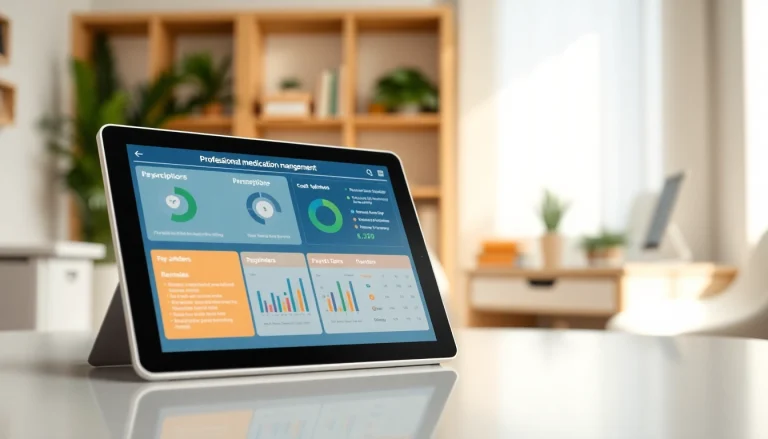
Understanding E-Prescribing Software
In the rapidly advancing landscape of healthcare, e-prescribing software serves as an essential tool for medical professionals. By streamlining the process of prescription management, it enhances efficiency and accuracy in patient care. Moreover, those looking to invest in such tools can benefit from exploring eprescribing software reviews. This article delves into the core components, benefits, and insights surrounding e-prescribing software to assist healthcare providers in making informed decisions.
What is E-Prescribing Software?
E-prescribing software is a digital application that allows healthcare providers to write and send prescriptions electronically. It replaces traditional paper prescriptions, facilitating direct communication between healthcare practitioners, pharmacies, and patients. This innovative technology aims to reduce errors and streamline workflows, ultimately improving patient safety and care quality.
Key Features of E-Prescribing Software
When evaluating e-prescribing software, several features should be considered, as they can significantly impact user experience and functionality:
- Interface Design: A user-friendly interface simplifies the prescription process, enabling quick access to patient data and prescriptions.
- Integration with EHR Systems: Seamless integration with Electronic Health Records (EHR) systems ensures that prescriptions are aligned with patient health data, making it easier for healthcare providers to make informed decisions.
- Medication Database: Access to a comprehensive medication database helps providers verify drug information, avoid harmful interactions, and ensure accurate dosing.
- Patient Management: Features like medication history, allergies, and previous prescriptions assist healthcare providers in delivering personalized care.
- Regulatory Compliance: E-prescribing software must comply with local and federal regulations, particularly when dealing with controlled substances.
- Security Measures: Ensuring patient data confidentiality is paramount; hence, robust security features should be a primary consideration.
- Support and Training: Ongoing support and training options are essential for maximizing the software’s utility.
Benefits of Using E-Prescribing Software
Adopting e-prescribing software in clinical practice offers numerous benefits, such as:
- Enhanced Efficiency: Reduces the time required for processing prescriptions, allowing medical staff to focus more on patient care.
- Fewer Errors: Minimizes the risk of misinterpretation due to handwriting errors common in traditional prescriptions.
- Improved Patient Safety: Alerts regarding drug interactions and allergies enhance overall patient safety, ensuring that patients receive appropriate therapy.
- Convenience: Patients can easily manage their medications via accessible online portals or mobile applications.
- Cost Savings: Streamlining prescribing processes can lead to decreased operational costs for healthcare facilities.
Evaluating E-Prescribing Software Reviews
Understanding e-prescribing software reviews is crucial for making an informed decision. These reviews provide insights into real user experiences, highlighting the strengths and weaknesses of different solutions.
Criteria for Analyzing E-Prescribing Software Reviews
When evaluating reviews, consider the following criteria to ensure a well-rounded assessment:
- User Experience: Look for comments on the software’s usability, support, and overall satisfaction.
- Features and Functionality: Reviews should detail specific features that users find beneficial or lacking.
- Integration Capabilities: Users often comment on how well the software integrates with existing systems.
- Customer Support: Take note of how responsive and effective the customer service is, as this can greatly impact the software’s usability.
- Cost vs. Value: Evaluate whether users feel they received sufficient value for the cost of the software.
Common User Experiences Highlighted in Reviews
User experiences with e-prescribing software can vary significantly. Common themes identified in reviews include:
- Simplicity vs. Complexity: Users appreciate intuitive interfaces that facilitate quick navigation; however, complex systems can frustrate healthcare providers.
- Training Requirements: Many users report needing extensive training to utilize all features effectively, highlighting a gap between the software’s capabilities and practicality.
- Efficiency Improvements: Positive feedback often emphasizes improvements in workflow efficiency and time savings.
- Technical Issues: Critiques often reference technical glitches or downtime that can hinder workflow.
Identifying Reliable Sources for Software Reviews
To ensure the credibility of software reviews, consider the following strategies:
- Reputable Platforms: Focus on reviews from established platforms known for their unbiased assessments.
- Diverse Perspectives: Read both positive and negative reviews across multiple sources to get a balanced view.
- Authorship Transparency: Prefer reviews where authors disclose relevant expertise or experience in the healthcare field.
Top E-Prescribing Software Solutions
Many e-prescribing software solutions are available, each boasting unique capabilities. This section compares some of the leading options to assist in finding the right fit.
Comparing Leading E-Prescribing Software Options
When evaluating different e-prescribing software solutions, consider the following aspects:
- Scalability: Solutions should cater to various practice sizes, from single practitioners to large healthcare networks.
- Customization: Flexibility in the software allows customization to match specific workflow needs.
- Interoperability: Effective solutions should interconnect seamlessly with existing health IT systems, promoting a holistic approach to care management.
Unique Selling Points of Top E-Prescribing Solutions
Identifying unique selling points can help differentiate between available options. Some software may prioritize:
- Advanced Analytics: Solutions that include data analytics capabilities can help healthcare providers make data-driven decisions.
- Patient Engagement Tools: Features enabling enhanced communication with patients can play a significant role in improving care outcomes.
- Mobility: Mobile-compatible options allow providers to manage prescriptions on-the-go, improving accessibility.
Built-in Features Worth Noting in Reviews
While each software package offers distinct features, certain built-in functionalities consistently receive positive feedback, such as:
- Instant Prescription Renewals: Simplifying the renewal process encourages medication adherence among patients.
- Secure Messaging: Enabling communication between providers and pharmacists mitigates potential prescription errors.
- Automated Refills: Providing convenience for patients and ensuring consistent medication availability.
Challenges and Considerations in E-Prescribing
While e-prescribing software brings numerous benefits, potential pitfalls and considerations warrant attention. Understanding these challenges can facilitate smoother implementation and usage.
Common Pitfalls in E-Prescribing Software
A few common challenges associated with e-prescribing software include:
- Lack of Training: Insufficient training can lead to improper use, resulting in frustration among both providers and patients.
- Integration Issues: Difficulties in integrating the software with existing systems can lead to workflow disruptions.
- User Resistance: Some healthcare providers may resist adopting new technologies, preferring traditional methods.
Regulatory Considerations in E-Prescribing
Healthcare providers must navigate a landscape filled with regulations concerning e-prescribing, especially for controlled substances.
The Drug Enforcement Administration (DEA) regulates electronic prescriptions for controlled substances. Any software used must comply with the DEA’s standards, ensuring that it incorporates necessary security features and authentication processes to deter misuse.
Tips for Adopting E-Prescribing Solutions
Here are some actionable tips for successfully adopting e-prescribing software:
- Conduct Thorough Research: Before choosing a solution, evaluate different options based on needs, budget, and integration capabilities.
- Provide Comprehensive Training: Invest in training sessions to empower all users to maximize the software’s features.
- Encourage Feedback: Foster an environment where healthcare providers can voice suggestions or concerns about the software’s performance.
Future Trends in E-Prescribing Software
The future of e-prescribing software is bright, with numerous advancements expected to shape its evolution. Awareness of these trends can help healthcare providers stay ahead of the curve.
The Impact of Technology on E-Prescribing
Emerging technology trends poised to transform e-prescribing include:
- Artificial Intelligence (AI): AI-powered features can enhance decision-making processes by analyzing patient data and yielding predictive insights.
- Blockchain Technology: Utilized for transaction security and data integrity, blockchain offers a promising avenue for safeguarding prescription data.
- Telehealth Integration: As telehealth continues to grow, e-prescribing solutions are likely to integrate seamlessly with remote care platforms, offering convenience to patients and providers alike.
Anticipated Developments in User Experience
Future innovations are likely to prioritize user-centric design principles, enhancing usability through:
- Improved Interfaces: A focus on intuitive design will simplify navigation and workflow processes for users.
- Personalization: E-prescribing solutions may evolve to offer personalized recommendations for providers based on their prescribing history and patient profiles.
- Enhanced Collaboration: Facilities that promote inter-provider communication will see higher patient satisfaction and engagement.
Preparing for Changes in E-Prescribing Regulations
Staying informed about regulatory changes is crucial for compliance. Providers should:
- Subscribe to Regulatory Updates: Following industry news ensures that healthcare providers remain compliant with evolving laws and regulations.
- Participate in Training Programs: Regular compliance training can prepare healthcare staff for any regulatory updates.
- Implement Feedback Mechanisms: Establishing channels for ongoing feedback allows practices to refine their processes continually in response to regulatory shifts.






